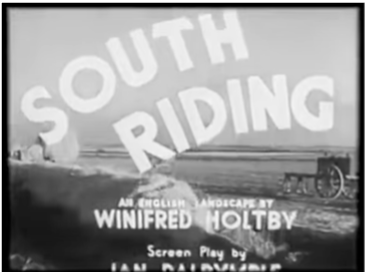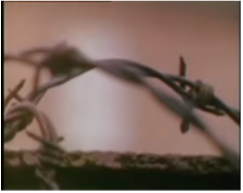Claire Gould (University of Reading)
When central characters Sarah Burton and Robert Carne meet for the first time in South Riding (Victor Saville, 1938), their awkward encounter on a country lane pitches their opposing impulses towards modernity or tradition into an argument over the right to occupy space on the road.1 Driving to be interviewed for the position of headmistress at the local girls’ school, Sarah’s way is blocked by the approach of the hunt being led by Robert, gentleman farmer of the Maythorpe estate. The horses startle at the sound of crunching gears, attracting Robert’s scorn for the woman driver who doesn’t understand the need to make way.

In Winifred Holtby’s 1936 novel, source material for Victor Saville’s 1938 film and two later television adaptations (1974, Yorkshire Television and 2011, BBC One), this meeting of social opposites occurs in the imposing interior of a council chamber.2 The film relocates the meeting to a country lane, distilling the stakes involved for the individual characters as they struggle to navigate the landscape at a time of change. Saville’s mobilisation of landscape in this scene, evoking the sense of time and place, viewed in parallel with the later screen interpretations, forms the basis for my analysis of the contrasting approaches to landscape and the past across successive screen versions of the novel.
Visions of the 1930s
It might be said, when watching Victor Saville’s film now, that it is ‘of its time’. The phrase has an apologetic tone when applied to an old film, an acknowledgment that production techniques such as back projection, mannered performances or outdated language make it a difficult watch for contemporary viewers. Watching the screen adaptations of South Riding alongside each other, I find the phrase takes on a different implication. Each of these productions are ‘of their time’ for reasons beyond technique and taste. As interpretations of British society in the 1930s, they are designed to be recognisable to their contemporary audience, with the later adaptations needing to (at least initially) align their productions with an idea of ‘the 30s’ as a period ‘between the wars’, barely distinguishable in the wider flow of British history. In both these television versions, it is the train, not the car, that transports Sarah Burton to South Riding.3 The nostalgic pleasures of the steam train are part and parcel with the details of costume and hairstyle in similar sequences, featuring the train’s whistle, squealing breaks and smoke swirling around the feet of disembarking passengers.






Sarah arrives by steam train in 1974 (top) and 2011 (bottom) television adaptations of South Riding
Returning to the scene on the country lane in Victor Saville’s film, a series of distinctions are drawn between the new-ness of the car, the established technology of the train and the much older role of the working horse in rural life, distinctions which are harder to discern in the later screen versions. Working from a contemporary text, the 1938 film emphasises the unfamiliarity of the car in a narrow lane. The sound of the engine is jarring, intruding on the softer sounds of birdsong and horses’ hooves. The awkwardness and uncertainty in the space, emphasised in the tight framing as the horses and car attempt to edge past each other, extends into the dialogue. Robert refers to the “motorcar” and Sarah responds by saying the horses should not be on the “motor-road”. It sounds unusual to modern ears for cars or roads to require this description. What other kind of road would there be? The short scene ends as Sarah sarcastically apologises for referring to the hunting hounds as “dogs”, her heavy emphasis drawing attention to the fact that her ‘error’ was a deliberate rejection of past language. That neither character knows quite how to refer to the future leaves the argument unresolved.




Frames 1-4: Who has right of way? Sarah (Edna Best) and Robert (Ralph Richardson) meet on the road in the film adaptation, South Riding (1938)
Battlefields and barbed wire
The richness of the source material in Winifred Holtby’s novel affords more than just the opportunity to faithfully reproduce period detail. Popular on publication, Holtby’s attack on the inadequate state of education, housing and health care in the 1930s clearly resonated for producers in 1974 and 2011, just as it inspired Alexander Korda and Victor Saville to produce it as an important contemporary work. Subtitled An English Landscape, Holtby encourages her readers to link local struggles to the wider state-of-the-nation, away from urban density. Film historian Lawrence Napper as described the 1930s as a ‘transitional time’ in British society, marked by the expansion of education and the professions, of housebuilding, development of the suburbs and the roads to connect them.4 These transitions are central to the local politics in South Riding, experienced in a landscape that imposes practical limitations, even as its wide horizons offer a space to imagine the future. Early in the novel, Sarah surveys the South Riding landscape, thinking of it as ‘her battlefield’, and in the same moment it occurs to her that she will need to buy a car. In this thought, Sarah’s grand ambitions for the future are made dependent on her freedom to move through the landscape.
While there’s no direct equivalent of the 1938 scene in the later screen adaptations, they all feature a version of the crucial scene that follows. Robert Carne’s horses are both his passion and his livelihood, and the hunt was meant to be an opportunity to show off his prize horse to a prospective buyer. When that horse bolts, galloping across the fields, it is fatally injured by barbed wire concealed in a hedge by a tenant farmer. The gruesome incident, and the allusion to ‘battlefields’ in Holtby’s writing, indicates a brutal and treacherous landscape. It’s a disturbing vision that emerges on screen in the disconnect between the pleasures of the landscape view and the experience of the characters within that landscape.

Danger in the landscape in the 1974 television adaptation of South Riding
If the subtleties of social transition are harder to discern in the period details of the TV adaptations, the dissonance they create in their treatment of the Yorkshire locations offers a clearer view of the shifting social ground, and with it an uncomfortable sense of recognition. The hidden dangers in the landscape are foreshadowed early in Stan Barstow’s 1974 television adaptation, as a tracking shot around the Maythorpe estate, showing the run-down house isolated in parkland sodden by rain, closes in on the barbed wire running around the paddock. The BBC’s adaptation of 2011 is the most fully immersed in the landscape, moving seamlessly between gloomy interiors and varied locations populated with period detail. The bleak, muddy expanse of the open countryside known as ‘the wastes’ dwarfs Councillor Beddows’s car, pressing around the windows as she drives to a planning meeting. The old tramcars and railway carriages that serve as dwellings for the residents of the ‘shacks’ are not so easily consigned to the past when the familiar landscape prompts a connection with the neglected rural areas of the present.


Immersion in landscape in the 2011 television adaptation of South Riding
Settled history?
Filmed at Denham Studios, in southern England, with Denham House and grounds standing-in for Maythorpe, Saville’s film doesn’t construct a regionally specific landscape.5 (But this didn’t prevent contemporary reviewers in Kine Weekly and Monthly Film Bulletin praising the authentic Yorkshire scenery.6) In common with the approach of the later TV versions, the film contrasts pictorial landscape views (in the form of a recurring montage of rural scenes) with the decaying state of the environment as experienced by the characters. Even in the first scene the shift in tone is a jolt, transitioning from the last pastoral view of the opening titles via a dissolve to a low angle shot of councillors Astell and Snaith assessing the landscape through a telescope. They are unmoved by the view, a visual echo from the opening titles. Snaith sees a business opportunity for his construction company if the ‘wastes’ are developed, Astell wants to have some decent homes for the destitute ‘shacks’ families. Whatever their motivations, their attitude to the landscape as just empty, ugly space, jars with the rural idyll conjured in the opening titles.



Titles play across pastoral scenes and, in the first scene, Astell and Snaith refer to the view as ‘the wastes’ in the film adaptation of South Riding (1938)
By the end of the Victor Saville’s film, the obstacles to Sarah and Robert’s romance are finally removed, but all the other pieces are still in motion. The ‘wastes’ will be developed and covered with new houses, the ‘shacks’ will be demolished and the luckier dwellers may move to the new housing. The local girls will have their school, and the bypass road will be completed. But the arguments about the future are not settled, the society is still in transition. We may look back and feel satisfied at all that was eventually achieved, or ponder on the absences and unfulfilled future promises in the landscapes in our own time.
Claire Gould is a PhD candidate at the University of Reading. Please contact claire.gould@pgr.reading.ac.uk with questions or comments.
Endnotes:
- Holtby, Winifred (1936) South Riding: an English landscape. London: Virago Modern Classics ↩︎
- South Riding (1938) Directed by V. Saville. Available at: archive.org https://archive.org/details/sr845454b(Accessed 01 October 2023). A later edit of the 1938 film is available at: YouTube https://www.youtube.com/watch?v=NYQ3vcr9Usg (missing an important early scene at ‘the shacks’, and the final Land of Hope and Glory scene) ↩︎
- South Riding (1974) Yorkshire Television. Available at YouTube https://www.youtube.com/watch?v=Dg_3s0wXvxA&t=67s (Accessed: 20 September 2023); South Riding (2011) BBC One. Available at Learning on Screen, BoB Service refs: 01A70054, 01AA7E5A, 01AD1BEE (Accessed: 20 September 2023). ↩︎
- Napper, L. (2012) ‘No limit: British class and comedy of the 1930s’, in Hunter, I.Q and Porter, L. (eds.) Oxon: Routledge, pp. 38-49. See also, Aldgate, A and Richards, J. H. (2009) Best of British: cinema and society from 1930 to the present. New edn. London: I.B. Tauris; Aldgate’s British Cinema in the 1930s: South Riding (1980) BBC Open University Production Centre. Can be viewed at BFI Mediatheque, London; Mitchinson, J. and Miller, A. (2022) Backlisted [Podcast]. 22 February 2022, episode 158 on South Riding. Available at: https://www.backlisted.fm/episodes/158-winifred-holtby-south-riding?rq=holtby (Accessed: 22 February 2022). ↩︎
- A Day at Denham (1939) United Artists. Available at: BFI Player (Accessed 01 May 2023) This short promotional film about Denham studios includes shots of scenes from South Riding being filmed. ↩︎
- Film Weekly (1938) ‘South Riding – film review’ v20 n483 (15 Jan), p25; Kine Weekly (1938) ‘South Riding – film review’ n1603 (06 Jan). ↩︎
Leave a comment